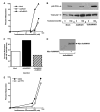The modulator of nongenomic actions of the estrogen receptor (MNAR) regulates transcription-independent androgen receptor-mediated signaling: evidence that MNAR participates in G protein-regulated meiosis in Xenopus laevis oocytes
- PMID: 15831520
- PMCID: PMC1482432
- DOI: 10.1210/me.2004-0531
The modulator of nongenomic actions of the estrogen receptor (MNAR) regulates transcription-independent androgen receptor-mediated signaling: evidence that MNAR participates in G protein-regulated meiosis in Xenopus laevis oocytes
Abstract
Classical steroid receptors mediate many transcription-independent (nongenomic) steroid responses in vitro, including activation of Src and G proteins. Estrogen-triggered activation of Src can be regulated by the modulator of nongenomic actions of the estrogen receptor (MNAR), which binds to estrogen receptors and Src to create a signaling complex. In contrast, the mechanisms regulating steroid-induced G protein activation are not known, nor are the physiologic responses mediated by MNAR. These studies demonstrate that MNAR regulates the biologically relevant process of meiosis in Xenopus laevis oocytes. MNAR was located throughout oocytes, and reduction of its expression by RNA interference markedly enhanced testosterone-triggered maturation and activation of MAPK. Additionally, Xenopus MNAR augmented androgen receptor (AR)-mediated transcription in CV1 cells through activation of Src. MNAR and AR coimmunoprecipitated as a complex involving the LXXLL-rich segment of MNAR and the ligand binding domain of AR. MNAR and Gbeta also precipitated together, with the same region of MNAR being important for this interaction. Finally, reduction of MNAR expression decreased Gbetagamma-mediated signaling in oocytes. MNAR therefore appears to participate in maintaining meiotic arrest, perhaps by directly enhancing Gbetagamma-mediated inhibition of meiosis. Androgen binding to AR might then release this inhibition, allowing maturation to occur. Thus, MNAR may augment multiple nongenomic signals, depending upon the context and cell type in which it is expressed.
Figures








References
-
- Cato AC, Nestl A, Mink S. Rapid actions of steroid receptors in cellular signaling pathways. Sci STKE. 2002;2002:RE9. - PubMed
-
- Edwards DP. Regulation of signal transduction pathways by estrogen and progesterone. Annu Rev Physiol. 2005;67:335–376. - PubMed
-
- Boonyaratanakornkit V, Scott MP, Ribon V, Sherman L, Anderson SM, Maller JL, Miller WT, Edwards DP. Progesterone receptor contains a proline-rich motif that directly interacts with SH3 domains and activates c-Src family tyrosine kinases. Mol Cell. 2001;8:269–280. - PubMed
-
- Pietras RJ, Szego CM. Specific binding sites for oestrogen at the outer surfaces of isolated endometrial cells. Nature. 1977;265:69–72. - PubMed
-
- Shaul PW. Rapid activation of endothelial nitric oxide synthase by estrogen. Steroids. 1999;64:28–34. - PubMed
Publication types
MeSH terms
Substances
Grants and funding
LinkOut - more resources
Full Text Sources
Other Literature Sources
Research Materials
Miscellaneous

